
Breadcrumb
PEMSEA Blue Economy
The Blue Economy encompasses all economic activities related to oceans, seas, and coastal areas, emphasizing sustainable development and responsible resource management. It recognizes the immense economic potential of marine resources while also acknowledging the need to protect and preserve marine ecosystems for future generations. From fisheries and aquaculture to tourism and renewable energy, the Blue Economy encompasses a wide range of sectors that rely on the health and vitality of marine ecosystems.
Within this framework, organizations like PEMSEA can play a crucial role in promoting sustainable Blue Economy practices. Through various initiatives, PEMSEA works to integrate environmental protection, economic development, and social equity, ensuring that Blue Economy activities benefit both people and the planet.
PEMSEA's work on Blue Economy-related topics focuses on promoting sustainable development practices that maximize the economic potential of marine resources while minimizing negative impacts on the environment. This includes initiatives to enhance fisheries management, promote sustainable aquaculture practices, and develop coastal tourism strategies, among other initiatives ranging from the local to the regional, taking into account transboundary considerations and cooperation.
One key aspect of PEMSEA's work is the development of integrated coastal management (ICM) frameworks that bring together government agencies, local communities, and other stakeholders to coordinate efforts for sustainable development. By promoting holistic approaches to coastal management, PEMSEA aims to balance economic growth with environmental conservation and social equity, and PEMSEA is integrating Blue Economy considerations into the ICM process together with its partners.
Additionally, PEMSEA provides technical assistance, capacity building, and knowledge sharing to support the implementation of Blue Economy initiatives at the local, national, and regional levels. Through partnerships with governments, academia, NGOs, and the private sector, PEMSEA facilitates the exchange of best practices and innovative solutions for sustainable Blue Economy development.
Selected PEMSEA publications:
Dongying Declaration on Building a "Blue Economy" through Integrated Coastal Management
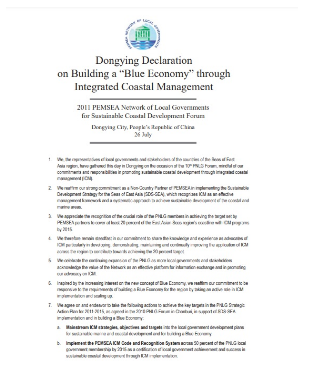 The Dongying Declaration on Building a "blue economy" through ICM embodies the commitment of the PEMSEA Network of Local Governments for Sustainable Coastal Development (PNLG) to implement the PNLG Strategic Action Plan (SAP) as well the commitment of the PNLG as a PEMSEA Non-Country Partner to implement the SDS-SEA. The Dongying Declaration was adopted in Dongying City, People's Republic of China last July 26, 2011.
The Dongying Declaration on Building a "blue economy" through ICM embodies the commitment of the PEMSEA Network of Local Governments for Sustainable Coastal Development (PNLG) to implement the PNLG Strategic Action Plan (SAP) as well the commitment of the PNLG as a PEMSEA Non-Country Partner to implement the SDS-SEA. The Dongying Declaration was adopted in Dongying City, People's Republic of China last July 26, 2011.
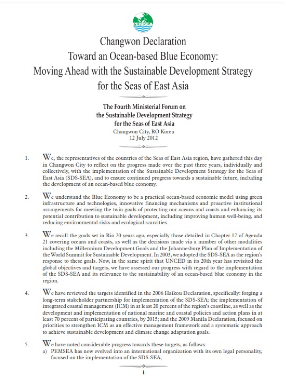 Signed during the Fourth Ministerial Forum on the Sustainable Development Strategy for the Seas of East Asia on 12 July 2012, the Changwon Declaration reflects on the progress made over the past three years with the implementation of the SDS-SEA, and ensures the continued progress towards a sustainable future, including the development of an ocean-based blue economy. Ministers from 10 countries of the East Asian Seas (EAS) signed the declaration. The Declaration is the region’s support for the implementation of theRio+20 Outcomes embodied in "The Future We Want," and other relevant international and regional commitments related to coasts and oceans. With the signing, Ministers and senior representatives from Cambodia, PR China, Indonesia, Japan, Lao PDR, the Philippines, RO Korea, Singapore, Timor-Leste, and Viet Nam adopted the Five-Year Regional Implementation Plan for the Sustainable Development Strategy for the Seas of East Asia (SDS-SEA) for 2012-2016. Thailand participated as an observer. The Declaration enables the development of an ocean-based blue economy in the region through the strengthened support for SDS-SEA implementation and other relevant initiatives. Under the Changwon Declaration, PEMSEA as the SDS-SEA implementing arm, targets the following changes in coastal and marine governance: (a) a self-sustained regional partnership mechanism for the implementation of the SDS-SEA; and (b) national coastal and ocean policies and supporting institutional arrangements in place in at least 70% of Partner Countries.
Signed during the Fourth Ministerial Forum on the Sustainable Development Strategy for the Seas of East Asia on 12 July 2012, the Changwon Declaration reflects on the progress made over the past three years with the implementation of the SDS-SEA, and ensures the continued progress towards a sustainable future, including the development of an ocean-based blue economy. Ministers from 10 countries of the East Asian Seas (EAS) signed the declaration. The Declaration is the region’s support for the implementation of theRio+20 Outcomes embodied in "The Future We Want," and other relevant international and regional commitments related to coasts and oceans. With the signing, Ministers and senior representatives from Cambodia, PR China, Indonesia, Japan, Lao PDR, the Philippines, RO Korea, Singapore, Timor-Leste, and Viet Nam adopted the Five-Year Regional Implementation Plan for the Sustainable Development Strategy for the Seas of East Asia (SDS-SEA) for 2012-2016. Thailand participated as an observer. The Declaration enables the development of an ocean-based blue economy in the region through the strengthened support for SDS-SEA implementation and other relevant initiatives. Under the Changwon Declaration, PEMSEA as the SDS-SEA implementing arm, targets the following changes in coastal and marine governance: (a) a self-sustained regional partnership mechanism for the implementation of the SDS-SEA; and (b) national coastal and ocean policies and supporting institutional arrangements in place in at least 70% of Partner Countries.
Blue Economy for Business in East Asia: Towards an Integrated Understanding of Blue Economy
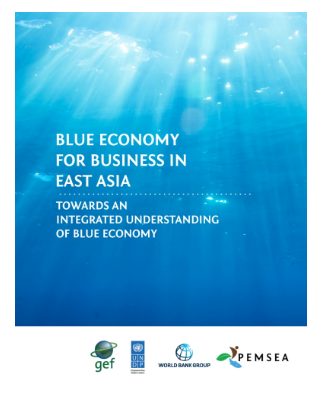 This report centers on one sector that plays a fundamental role in the economy, but which has received lesser attention thus far in the blue economy discussion: business. The focus is on businesses operating in coastal and marine areas in East Asia, a region where the seas are essential to the lives and economies of its people. From the perspective of industry, the report aims to define and establish an understanding of the importance of blue economy and how it might impact various industries and, ultimately, provide a roadmap to help companies make better decisions to position themselves competitively in the growing blue economy.
This report centers on one sector that plays a fundamental role in the economy, but which has received lesser attention thus far in the blue economy discussion: business. The focus is on businesses operating in coastal and marine areas in East Asia, a region where the seas are essential to the lives and economies of its people. From the perspective of industry, the report aims to define and establish an understanding of the importance of blue economy and how it might impact various industries and, ultimately, provide a roadmap to help companies make better decisions to position themselves competitively in the growing blue economy.
Enabling Blue Economy Investment for Sustainable Development in the Seas of East Asia
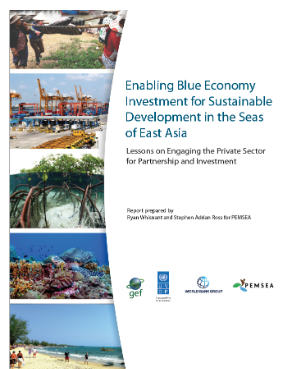 In collaboration with other regional and international organizations, PEMSEA has undertaken a significant body of work to advance both the understanding and practice around blue economy and investment in sustainable development of coasts and oceans. This report provides an update on the current state of blue economy investment in East Asia, with lessons learned and recommendations for international development organizations to help advance blue economy investment.
In collaboration with other regional and international organizations, PEMSEA has undertaken a significant body of work to advance both the understanding and practice around blue economy and investment in sustainable development of coasts and oceans. This report provides an update on the current state of blue economy investment in East Asia, with lessons learned and recommendations for international development organizations to help advance blue economy investment.
Policy Brief for the Blue Economy - Sustainable Fishing and Aquaculture
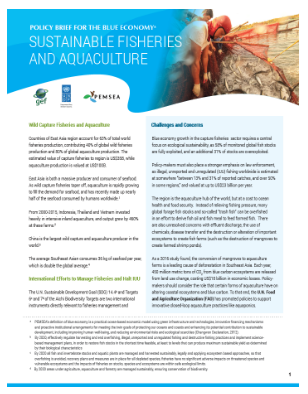 Countries of East Asia region account for 63% of total world fisheries production, contributing 40% of global wild fisheries production and 80% of global aquaculture production. The estimated value of capture fisheries to region is US$35B, while aquaculture production is valued at US$100B. East Asia is both a massive producer and consumer of seafood. As wild capture fisheries taper off, aquaculture is rapidly growing to fill the demand for seafood, and has recently made up nearly half of the seafood consumed by humans worldwide.
Countries of East Asia region account for 63% of total world fisheries production, contributing 40% of global wild fisheries production and 80% of global aquaculture production. The estimated value of capture fisheries to region is US$35B, while aquaculture production is valued at US$100B. East Asia is both a massive producer and consumer of seafood. As wild capture fisheries taper off, aquaculture is rapidly growing to fill the demand for seafood, and has recently made up nearly half of the seafood consumed by humans worldwide.
Policy Brief for the Blue Economy - Renewable Ocean Energy
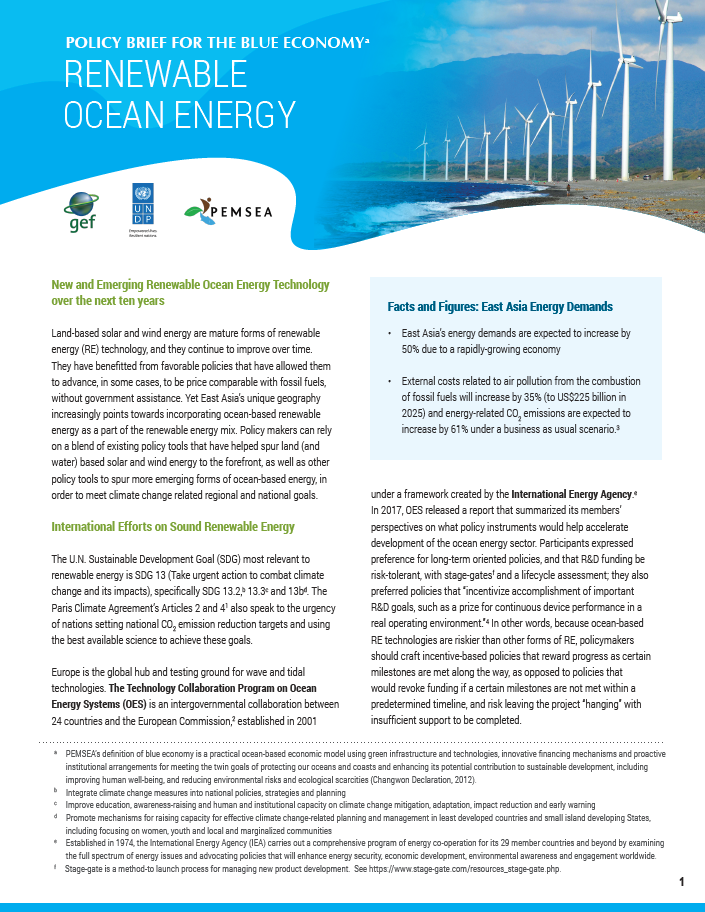 Land-based solar and wind energy are mature forms of renewable energy (RE) technology, and they continue to improve over time. They have benefitted from favorable policies that have allowed them to advance, in some cases, to be price comparable with fossil fuels, without government assistance. Yet East Asia’s unique geography increasingly points towards incorporating ocean-based renewable energy as a part of the renewable energy mix. Policy makers can rely on a blend of existing policy tools that have helped spur land (and water) based solar and wind energy to the forefront, as well as other policy tools to spur more emerging forms of ocean-based energy, in order to meet climate change related regional and national goals.
Land-based solar and wind energy are mature forms of renewable energy (RE) technology, and they continue to improve over time. They have benefitted from favorable policies that have allowed them to advance, in some cases, to be price comparable with fossil fuels, without government assistance. Yet East Asia’s unique geography increasingly points towards incorporating ocean-based renewable energy as a part of the renewable energy mix. Policy makers can rely on a blend of existing policy tools that have helped spur land (and water) based solar and wind energy to the forefront, as well as other policy tools to spur more emerging forms of ocean-based energy, in order to meet climate change related regional and national goals.
Policy Brief for the Blue Economy - Sustainable Tourism
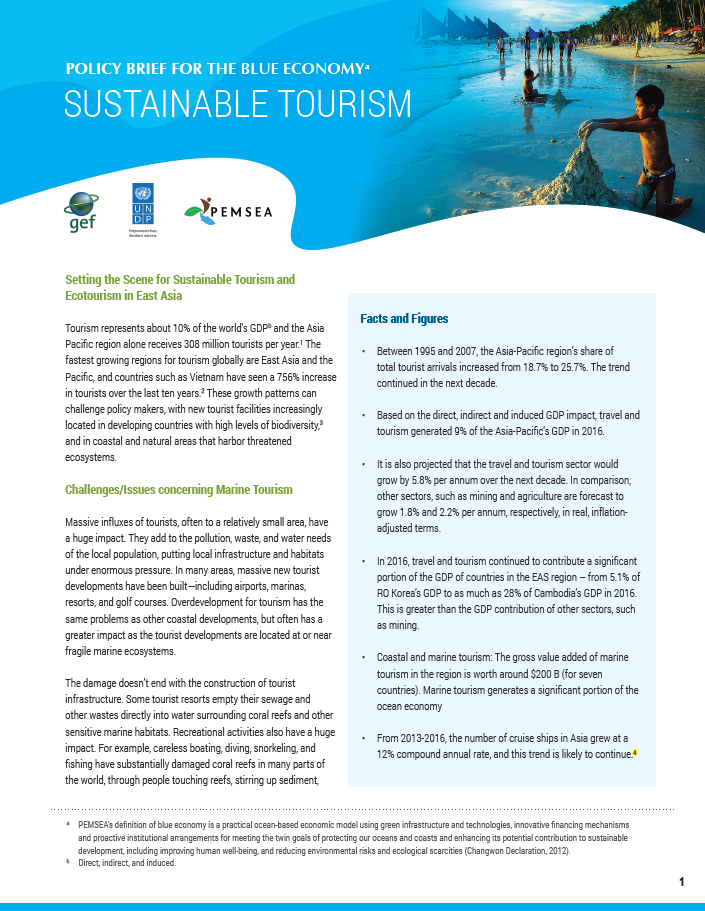 Tourism represents about 10% of the world’s GDP and the Asia Pacific region alone receives 308 million tourists per year. The fastest growing regions for tourism globally are East Asia and the Pacific, and countries such as Vietnam have seen a 756% increase in tourists over the last ten years. These growth patterns can challenge policy makers, with new tourist facilities increasingly located in developing countries with high levels of biodiversity, and in coastal and natural areas that harbor threatened ecosystems.
Tourism represents about 10% of the world’s GDP and the Asia Pacific region alone receives 308 million tourists per year. The fastest growing regions for tourism globally are East Asia and the Pacific, and countries such as Vietnam have seen a 756% increase in tourists over the last ten years. These growth patterns can challenge policy makers, with new tourist facilities increasingly located in developing countries with high levels of biodiversity, and in coastal and natural areas that harbor threatened ecosystems.
Policy Brief for the Blue Economy - Sustainable Shipping and Ports
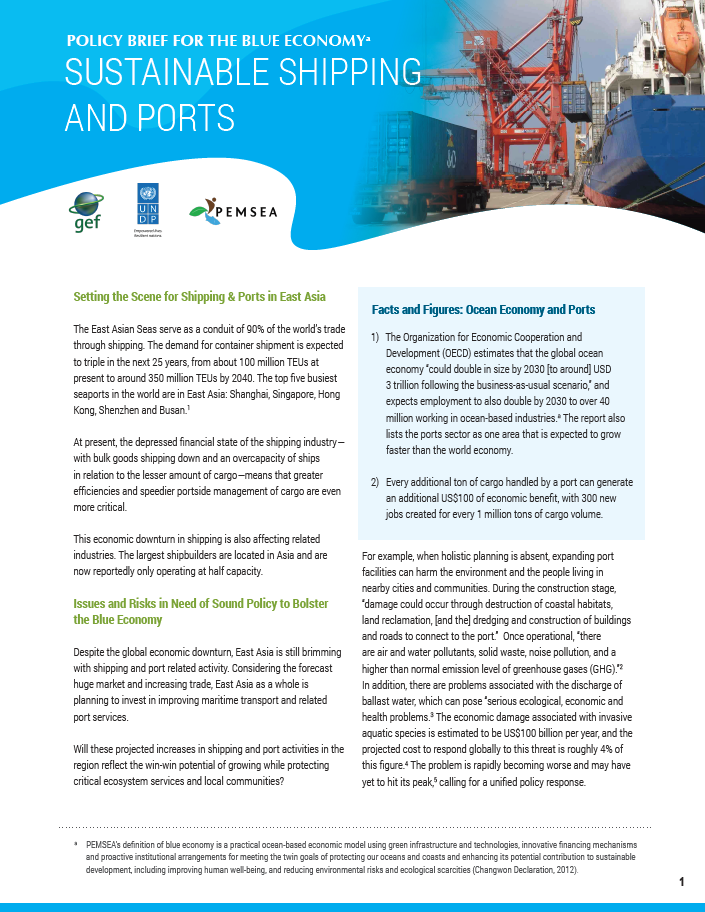 The East Asian Seas serve as a conduit of 90% of the world’s trade through shipping. The demand for container shipment is expected to triple in the next 25 years, from about 100 million TEUs at present to around 350 million TEUs by 2040. The top five busiest seaports in the world are in East Asia: Shanghai, Singapore, Hong Kong, Shenzhen and Busan. Considering the forecast huge market and increasing trade, East Asia as a whole is planning to invest in improving maritime transport and related port services. Will these projected increases in shipping and port activities in the region reflect the win-win potential of growing while protecting critical ecosystem services and local communities?
The East Asian Seas serve as a conduit of 90% of the world’s trade through shipping. The demand for container shipment is expected to triple in the next 25 years, from about 100 million TEUs at present to around 350 million TEUs by 2040. The top five busiest seaports in the world are in East Asia: Shanghai, Singapore, Hong Kong, Shenzhen and Busan. Considering the forecast huge market and increasing trade, East Asia as a whole is planning to invest in improving maritime transport and related port services. Will these projected increases in shipping and port activities in the region reflect the win-win potential of growing while protecting critical ecosystem services and local communities?
State of Oceans and Coasts 2018 : Blue Economy Growth in the East Asian Region
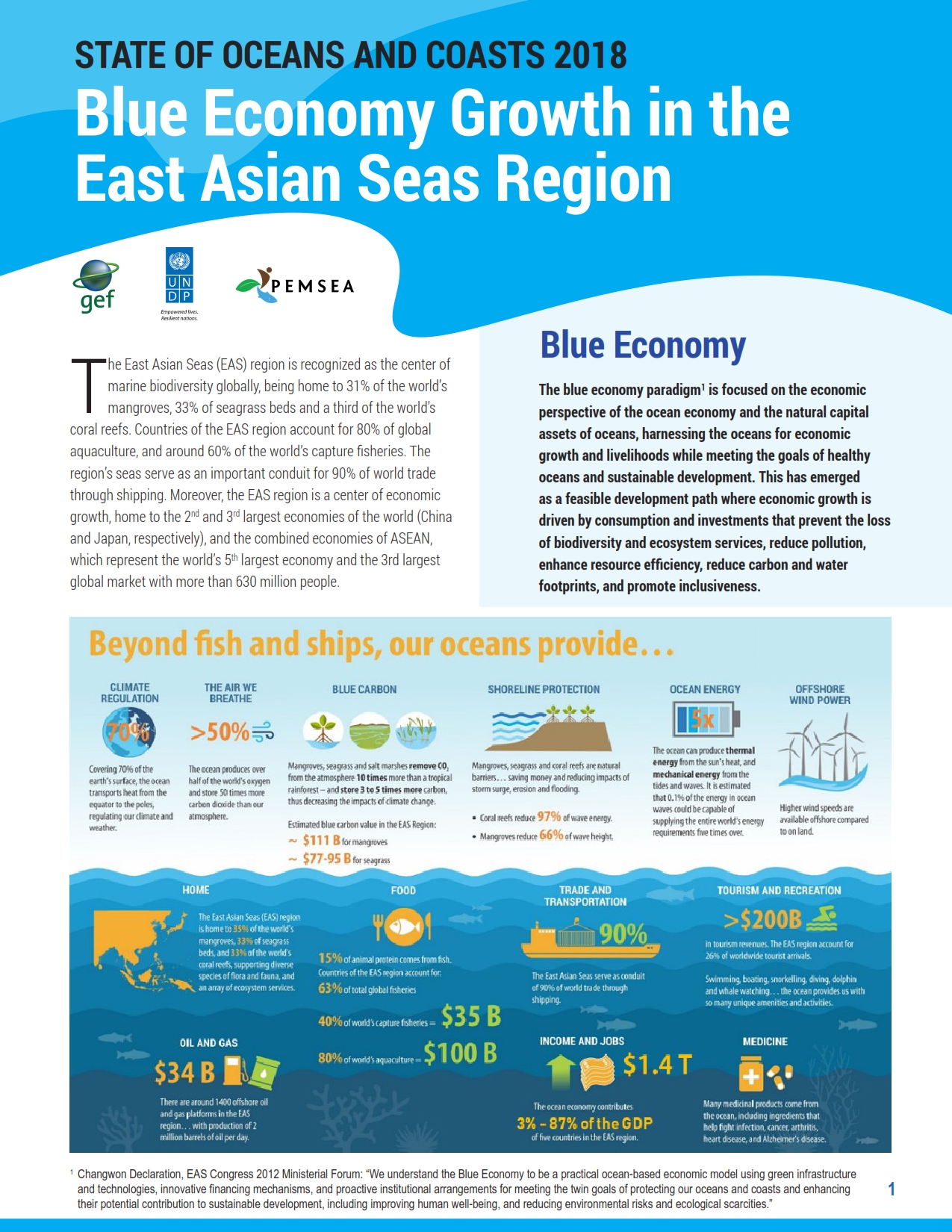 The East Asian Seas (EAS) region is recognized as the center of marine biodiversity globally, being home to 31% of the world’s mangroves, 33% of seagrass beds and a third of the world’s coral reefs. Countries of the EAS region account for 80% of global aquaculture, and around 60% of the world’s capture fisheries. The region’s seas serve as an important conduit for 90% of world trade through shipping. Moreover, the EAS region is a center of economic growth, home to the 2nd and 3rd largest economies of the world (China and Japan, respectively), and the combined economies of ASEAN, which represent the world’s 5th largest economy and the 3rd largest global market with more than 630 million people. State of Ocean and Coasts (SOC) Reports of Cambodia, China, Indonesia, Japan, Malaysia, Philippines, RO Korea, Singapore, Thailand, Timor-Leste, and Viet Nam capture initial estimates of their ocean economies – measured as the sum of the economic activities of ocean-based and ocean-related industries, together with the natural assets, goods and services of marine ecosystems upon which these industries depend and people rely on for food, income, livelihood, recreation, shoreline protection and climate regulation, among others.
The East Asian Seas (EAS) region is recognized as the center of marine biodiversity globally, being home to 31% of the world’s mangroves, 33% of seagrass beds and a third of the world’s coral reefs. Countries of the EAS region account for 80% of global aquaculture, and around 60% of the world’s capture fisheries. The region’s seas serve as an important conduit for 90% of world trade through shipping. Moreover, the EAS region is a center of economic growth, home to the 2nd and 3rd largest economies of the world (China and Japan, respectively), and the combined economies of ASEAN, which represent the world’s 5th largest economy and the 3rd largest global market with more than 630 million people. State of Ocean and Coasts (SOC) Reports of Cambodia, China, Indonesia, Japan, Malaysia, Philippines, RO Korea, Singapore, Thailand, Timor-Leste, and Viet Nam capture initial estimates of their ocean economies – measured as the sum of the economic activities of ocean-based and ocean-related industries, together with the natural assets, goods and services of marine ecosystems upon which these industries depend and people rely on for food, income, livelihood, recreation, shoreline protection and climate regulation, among others.